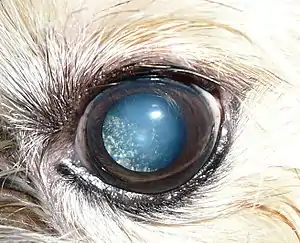Asteroid hyalosis
Asteroid hyalosis is a degenerative condition of the eye involving small white opacities in the vitreous humor. It is known to occur in humans, dogs, cats, horses, and chinchillas.[1] Clinically, these opacities are quite refractile, giving the appearance of stars (or asteroids) shining in the night sky—except that ocular asteroids are often quite mobile. Ocular asteroids must be distinguished from the more common typical vitreous floaters, which are usually fibrillar or cellular condensates. The cause of asteroid hyalosis is unknown, but it has been associated with diabetes mellitus,[2] hypertension, hypercholesterolemia,[3] and, in certain animals, tumors of the ciliary body.[4] In dogs, asteroid hyalosis is considered to be an age related change.[5] The asteroid bodies are made up of hydroxylapatite, which in turn consists of calcium and phosphates or phospholipids.[6] While asteroid hyalosis does not usually severely affect vision, the floating opacities can be quite annoying, and may interfere significantly with visualization and testing of the retina.[7] While treatment of asteroid hyalosis is usually unnecessary, vitrectomy may occasionally be indicated, for both diagnostic and therapeutic purposes.[8][9]
| Asteroid hyalosis | |
|---|---|
 | |
| Asteroid hyalosis in a Yorkshire Terrier | |
| Specialty | Ophthalmology |
See also
References
- Wang M, Kador P, Wyman M (2006). "Structure of asteroid bodies in the vitreous of galactose-fed dogs". Mol Vis. 12: 283–9. PMID 16617295.
- Akram A, Niazi M, Ishaq M, Azad N (2003). "Frequency of diabetics in asteroid hyalosis patients". J Ayub Med Coll Abbottabad. 15 (3): 10–1. PMID 14727330.
- Bergren R, Brown G, Duker J (1991). "Prevalence and association of asteroid hyalosis with systemic diseases". Am J Ophthalmol. 111 (3): 289–93. doi:10.1016/s0002-9394(14)72311-6. PMID 2000898.
- Gelatt, Kirk N., ed. (1999). Veterinary Ophthalmology (3rd ed.). Lippincott, Williams & Wilkins. ISBN 0-683-30076-8.
- Bjerk, Ellen (2004). "Ocular Disease of the Aging Dog". Proceedings of the 29th World Congress of the World Small Animal Veterinary Association. Retrieved 2007-03-23.
- Komatsu H, Kamura Y, Ishi K, Kashima Y (2003). "Fine structure and morphogenesis of asteroid hyalosis". Med Electron Microsc. 36 (2): 112–9. doi:10.1007/s00795-002-0211-y. PMID 12825125.
- Wong S, Sampath R (2002). "Erroneous automated refraction in a case of asteroid hyalois". J Cataract Refract Surg. 28 (9): 1707–8. doi:10.1016/S0886-3350(01)01224-X. PMID 12231337.
- Olea Vallejo J, Muñoz Corrales E, Mateos Poch J, Mulet Perera P, Suñer Capo M (2002). "[Vitrectomy for asteroid hyalosis]". Arch Soc Esp Oftalmol. 77 (4): 201–4. PMID 11973661.
- Feist R, Morris R, Witherspoon C, Blair N, Ticho B, White M (1990). "Vitrectomy in asteroid hyalosis". Retina. 10 (3): 173–7. doi:10.1097/00006982-199001030-00003. PMID 2236940.